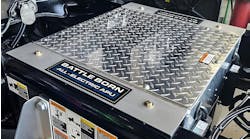The Federal Highway Administration's (FHWA) long-awaited hours-of-service proposal due out soon will most likely contain changes in current rules that require drivers to take off a minimum of eight hours for every ten hours on the road. While these prescriptive, one-size-fits-all rules will be a part of motor-carrier regulations for the foreseeable future, FHWA is launching an alternative that may offer trucking companies an option.
"There are a host of things that can be done instead of simply telling everyone how long they can drive and how much they must rest," says Ron Knipling, chief, research division, Office of Motor Carriers Research and Standards. He notes that monitoring drivers' alertness and allowing them to drive only when they can do so safely may offer crash-reduction benefits, as well as significant productivity gains. Performance-based fatigue management would permit many drivers to drive longer and with more flexible hours, while offering a higher safety performance level.
Technology coupled with basic research will yield the answer. While there are several ways to measure driver alertness, the most promising method is called PERCLOS -- the percent of time that eyelids are closed 80% or more. "Recent studies have further validated PERCLOS as a good measure of driver alertness," says Knipling. Quite simply, there is a high correlation between how droopy our eyelids get and how tired we really are. Because the changes in our eyelids are slow, subtle, and measurable, PERCLOS techniques allow us to identify a tired driver before he is seriously impaired by fatigue.
As luck would have it, the relationship between drooping eyelids and tiredness is universal. So, while some people need more sleep than others, and some drivers can drive longer hours than others, everyone whose eyelids droop to a certain level suffer from enough fatigue to be considered an unsafe operator. This level is measured using sensors to detect eyelid position and mathematical equations to convert it into fatigue levels that can be fed back to the driver.
Until recently, PERCLOS research has been relegated to the laboratory or relied on data that was collected from drivers and fed into databases for subsequent study. Now, PERCLOS is entering a phase of real-time, real-world monitoring and feedback.
Starting this month, 16 drivers from Pitt Ohio Express will work their regular 10-hour day then head for another 6 hours in a simulator at the University of Pennsylvania. The program will end March 1999. An operational, over-the-road test may be available by 2000, according to Paul Rau, program manager, Drowsy Driver Technology Program, Office of Crash Avoidance at the National Highway Traffic Safety Administration. One of the most difficult aspects of the project is producing a real-time eye sensor, but researchers at Carnegie-Mellon are making great strides in that area.
"PERCLOS has the most promise of any technology to determine alertness," says Rau, "but there are interesting issues not related to technology that we must address." One of the most pressing issues is how drivers will use the feedback. Because PERCLOS can tell drivers that they are getting progressively tired, how will they use that information? Rau compares it to a fuel gauge. Some drivers will look for the nearest diesel stop, while others may push it further and hope for luck.
Another concern is whether the feedback interrupts an operator's driving patterns, which may include microsleeps -- infinitesimally small bursts of sleep that help drivers go beyond their limits. Although not a safe habit, research has shown many people, not just drivers, unconsciously use microsleep to help them finish their tasks. Rau adds that many professional drivers have their own personal ways of fightingfatigue, and PERCLOS may interfere with these "tricks."
Although the system provides obvious benefits, such as fewer crashes, higher productivity, and more flexibility in driver scheduling, officials say they won't mandate it until the life-cycle cost comes down to about $1,000 per vehicle.
Using technology to measure driver alertness would change trucking forever. "We've been trying to crack this nut for 20 to 30 years," adds Rau. "We're very close."
OEM ups truck production south of the border to meet U.S. Class 8 demand
Freightliner Corp. says it will double daily production of its Class 8 highway trucks in Mexico to provide 4,000 FLD units for export to the United States.
This development accompanies actions recently announced by the OEM to boost production at its five plants in Oregon and North Carolina. In the U.S., Freightliner says it will operate three production shifts, plus Saturday production days, and hire 1,300 more manufacturing workers.
The latest announcement came April 24 at a ceremony celebrating the company's $9-million investment in the Mercedes-Benz factory in Santiago Tianguistenco, outside Mexico City.
Addressing the attendees was the president of Mexico, Ernesto Zedillo Ponce de Leon. Zedillo applauded the expansion's economic impact, including the creation of 600 new jobs. Other speakers included Jim Hebe, president & CEO of Freightliner, and Federico Korte, president of Mercedes-Benz Mexico S.A. de C.V.
"Our U.S. plants are operating around the clock and we still require additional production capacity to fill customer orders," said Hebe. "Our production expansion in Mexico is consistent with the intent -- and the benefits -- of NAFTA."
According to Hebe, the Mercedes-Benz plant has the "capability and capacity" to eventually export "somewhere from 6,000 to 8,000 trucks a year" to the U.S. He noted that the OEM had future plans in the works to produce U.S.-bound Freightliners at the plant, but Class 8 demand north of the border "created a sense of urgency to compress the time span."
Hebe said employees in the U.S. have not objected to the Mexican exports because "they realize that with all our people and plants at full capacity, it is an advantage for the company to capitalize on market demand. They also know we aren't cutting jobs anywhere to do this.
"However," he added, "we're not ramping up here for only a short-term solution. Rather, this plant is being integrated into our North American production structure."
In addition to the Freightliners it builds for domestic and export markets, the plant will also continue to manufacture Mercedes-Benz truck and car models for Mexico, as well as Central and South American markets.
Current production at the plant includes 4,000 Freightliner and 4,000 Mercedes-Benz trucks. Of those, 7,300 are earmarked for Mexico and 700 for export to elsewhere in Latin America.
Hebe also said that Freightliner expects to introduce its Sterling Truck Corp. subsidiary to Mexico. But he stated that no timetable has yet been set for that launch.
To mark the special occasion, Freightliner donated a new, fully outfitted Business Class fire truck to the plant's local community. Hebe said the gift was intended to be "of real benefit to all the families of the region," who have recently suffered numerous ground fires brought on by a long spell of dry weather.
Pending stockholder and regulatory agency approval, Dana Corp. will acquire the automotive aftermarket giant Echlin Inc. in a tax-free stock swap announced last month. The merger is expected to give Dana better access to the aftermarket for its automotive OE components while helping Echlin to expand into OE markets around the world.
The combined company will produce fuel system and engine management components, brakes, and drivetrain components for the automobile, truck, and off-highway vehicle markets under well-known brand names such as Raybestos, Spicer, Perfect Circle, Victor Reinz, and Wix. Combined annual sales are expected to be about $13 billion.
"In short, Echlin helps us in the aftermarket. Dana helps Echlin in original equipment," says Southwood J. Morcott, Dana chairman and CEO.
After the merger, Echlin will operate as the Echlin Strategic Business Unit of Dana. It will be headed by Larry McCurdy, current chairman, president and CEO of Echlin.
Coming off one of the most pleasantly surprising years in the history of truck sales, dealers and manufacturers gathered in Nashville for the annual conference of the American Truck Dealers brimming with confidence that the winds of economic expansion will keep their sails full well into 1999.
The only cloud on the horizon is the continued profitability of the industry. "We are still selling trucks at price levels that existed 10 years ago," said Mark C. Pigott, PACCAR chairman and CEO. "We need to find a way to increase the profit at all levels.
"Despite the bullish production levels, the consolidation of the industry will continue as manufacturers seek to increase unit volumes to justify major increases in spending on research and development and improved quality," he added.
Low profitability also plagues customers, Pigott noted. In order to survive, fleets must either grow larger to exercise their pricing leverage in the marketplace, or they must direct their efforts at niche markets. Either way, they are reviewing the cost structures traditionally associated with truck ownership and maintenance.
In addition to understanding the end user better, dealers must take a more active role in running their business, Pigott urged. This means getting involved in trucking policy formulation, supporting a diverse and highly trained work force, and embracing technology.
Increasingly, technology governs all aspects of a dealer interaction with a customer. "Today, 30% of all truck operators own a PC," Pigott said. "Within three years, one-half of all truck buyers will access the Internet for technical information to complete a financial application or to facilitate truck ordering."
Deputy U.S. Transportation Secretary Mortimer L. Downey announced that DOT will hold a national summit meeting within several months on the effect, if any, of the "Year 2000" computer problem on intelligent transportation systems. The effort is part of the Administration's ongoing Council on Year 2000 Conversion Program to ensure that federal agencies' computers function after January 1, 2000. Some computers may experience problems because their operating systems were not programmed to recognize any date that does not begin with the digits "19," as in 1998.
ITS systems such as synchronized traffic signals, weigh-station bypass equipment, electronic tolls, and vehicle locators could be affected. In addition, trucking firms may find their own internal computer systems affected.
Roger Gilroy, a spokesman for ITS America, said his group supports Downey's initiative and will wait to see what is learned at the summit meeting before advising its members. He said that its committees have not raised the issue, perhaps because the majority of ITS systems are relatively new and have been designed with the Year 2000 situation in mind.
FLEET OWNER is moving. Effective late July, the new office location will be 11 River Bend Drive South, Stamford, Conn. 06907. While direct-dial telephone numbers were unavailable at presstime, the toll-free number will remain 800-776-1246.
The move represents a consolidation of Intertec Publishing Co.'s New York- and Connecticut-based publications. This opportunity to consolidate was made possible by Intertec's acquisition of Cowles Business Media in March of this year.
Highway reauthorization bill Congress passed the six-year, $211-billion reauthorization of the highway bill May 22, just in time for the Memorial Day recess. President Clinton is expected to sign it.
ABS update A clarification on ABS rules for medium- and heavy-duty vehicles has been issued by NHTSA. Fleets must retain and maintain ABS on equipment built after the following dates: March 1, 1997, for tractors with air brakes; March 1, 1998, for all other air-braked trucks and trailers; March 1, 1999, for hydraulic-braked medium and heavy vehicles. Fleets that buy such equipment can't disable the ABS and must retain and maintain it for the life of the vehicle. Older vehicles do not have to be retrofitted with ABS.
Trailer retreads NHTSA has been petitioned by the Tire Retreading Institute to allow installing manufacturer-supplied retreads on new trailers. But the agency says lack of tire performance standards for that application raise safety concerns. As a result, active rulemaking on this proposal ended in April.
CDL renewals The Office of Motor Carriers is expected to initiate a rulemaking that would require drivers to present medical certificates verifying "physical qualification" when they renew their commercial driver's licenses. No issue date has yet been set for this rulemaking.
Haz-mat ID The Dept. of Transportation has issued new rules for identifying hazardous materials in transportation. Changes include clarification and revision of requirements for displaying ID numbers for large-quantity haz-mat shipments and those for non-bulk haz-mat packages poisonous via inhalation. Also covered are new methods for placing the carrier's phone number on vehicle exteriors.
Things are changing in the trailer market," said Dick Metzler, senior vp-worldwide marketing for Transport International Pool (TIP), during a recent press conference held by the giant trailer lessor.
According to Metzler, the current "moderate economic expansion" bodes well for the trailer market. However, he cautioned to watch out for a "speed bump" as the economy moves into an "orderly slowdown" next year. "The economy will experience slower but steadier growth," he continued, "which means there's no chance of seeing the kind of trailer overcapacity that occurred in '95."
At this point, says Metzler, new trailer shipments are finally catching up to tonnage demands. "Larger carriers are replacing more units with new equipment," he advised, "while smaller fleets seem more bearish."
Metzler announced TIP's new Peak Season Trailer Guarantee, a limited, money-back guarantee on the availability of 48- and 53-ft. dry vans during customers' peak-demand seasons.
Dennis Puccio, vp-sourcing, explains that TIP's new Supplier Scorecard program aims to improve the quality of the trailers it buys and at the same time, radically shorten delivery times.
For its part, TIP is training suppliers on the areas it believes are "critical to quality" (CTQ). "After hands-on training at all of our major suppliers," Puccio related, "the CTQ issues were reduced to a checklist to be completed by the manufacturer's last quality-control person, before the unit is deemed ready to ship." He noted the same checklist is then run through again when the trailers reach TIP branches.
In a similar vein, TIP has embarked on a quarterly Customer Scorecard program. "We solicit feedback from our customers on trailer suppliers and on how well we are responding to their needs," said Judith Millsaps, senior vp-quality.
If a customer gives any category less than a "C" grade, TIP develops a customized action plan to either correct the problem or at least set a timeline for improvement to occur.



